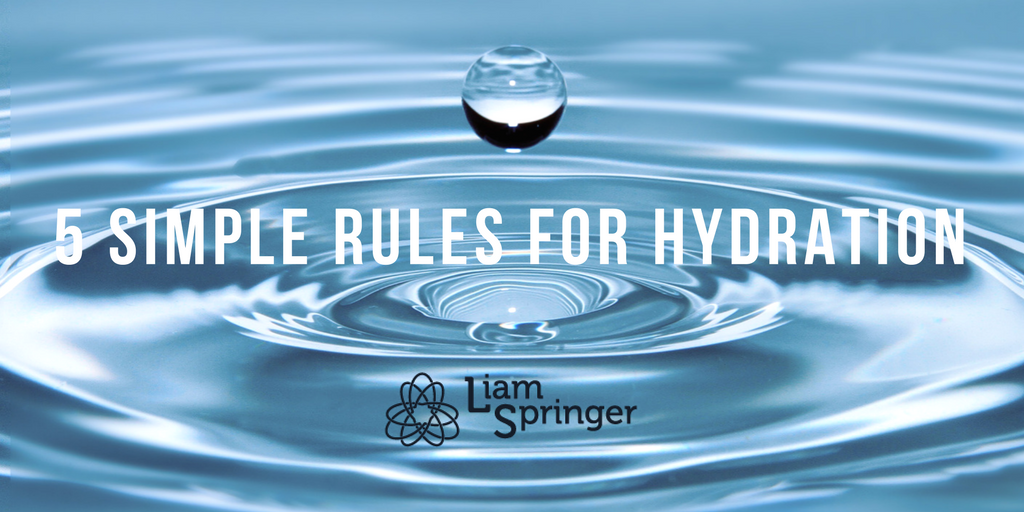 Hydration is a very complex topic. If you read my previous post, you already know that there’s no clear-cut answer to the question, “How much water should you drink?” The idea that “more is better” is simply not true. Good hydration is really about maintaining a good balance between water and mineral intake to help promote the ideal placement of water within the body. So how do you achieve a good balance? This post provides some general rules for hydration designed to help you maintain healthy fascia and stay well-hydrated.
Hydration is a very complex topic. If you read my previous post, you already know that there’s no clear-cut answer to the question, “How much water should you drink?” The idea that “more is better” is simply not true. Good hydration is really about maintaining a good balance between water and mineral intake to help promote the ideal placement of water within the body. So how do you achieve a good balance? This post provides some general rules for hydration designed to help you maintain healthy fascia and stay well-hydrated.
5 Simple Rules for Hydration
Remember: To maintain healthy hydration, the water you drink must be balanced with appropriate nutrition and minerals. When you drink the water and what you’ve been doing before and after are essential variables to consider. With those basic principles in mind, here are five simple rules for hydration:
- Drink water that contains minerals, such as spring water and water from natural underground reservoirs.
- Drink water on an empty stomach, 30 minutes before you eat and 2 hours after.
- Drink water before each meal, stopping 30 minutes prior to eating.
- Make sure you stretch your fascia using Myofascial Stretching techniques to allow the movement of fluid through the tissues. This is important because the health of the fascia—and therefore the overall health of the entire body—is fundamentally linked to the hydration of the tissues. Learn more about the importance of fascial health.
- Make sure you have a mineral-rich diet including fruit, dairy, vegetables, and salt.
If your metabolism and fascia are healthy and functional, drinking between 2–4 liters per day is a good benchmark. However, if you are unhealthy, drinking that much water could actually make things worse.
For related tips, check out my previous posts: How to Optimize Your Workout with Nutrition (featuring my orange juice sports drink recipe) and Nutrition Tips for Morning, Noon, and Evening Exercisers.
A Note on the Complexity of the Hydration Process
Even though the rules for hydration listed above are quite simple, remember that hydration is a complex process. It involves a delicate balance among the water and minerals distributed throughout the entire body. Consider the following scenarios:
- If you have been chronically dehydrated, your body’s ability to efficiently draw new water into and through the fascia is also impaired. In this case, it’s important to slowly increase the water you drink so you don’t simply dilute the blood.
- If you have been chronically dehydrated, you may be low in potassium or magnesium or relatively too high or low in sodium, depending on the amount of sodium in your diet. This affects your mineral-regulating hormones and kidney function.
- If you eat a lot of sodium and not enough water, you will be inclined to over-excrete sodium. If you then begin drinking water, you will rapidly become too low in sodium, which is a dangerous condition called hyponatremia.
- If you restrict sodium regularly, you will be inclined to retain sodium. If you then begin eating a more normal amount of salt, water will be retained along with it in your system. In this case, it’s best to increase salt slowly over a few days. The gradual increase in salt will reduce the kidney’s retention of sodium, and the water can then begin to move through your system more efficiently.
For more info on the hydration process and the importance of balancing your water and sodium intake, read my previous post: How Much Water Should You Drink?
For more insights on the latest topics in health and nutrition, sign up for my monthly newsletter. Want to try a new exercise method that’s great for fascial health, posture, and flexibility? Visit BTMAStudios.com to register for ELDOA group classes in St. Louis!






